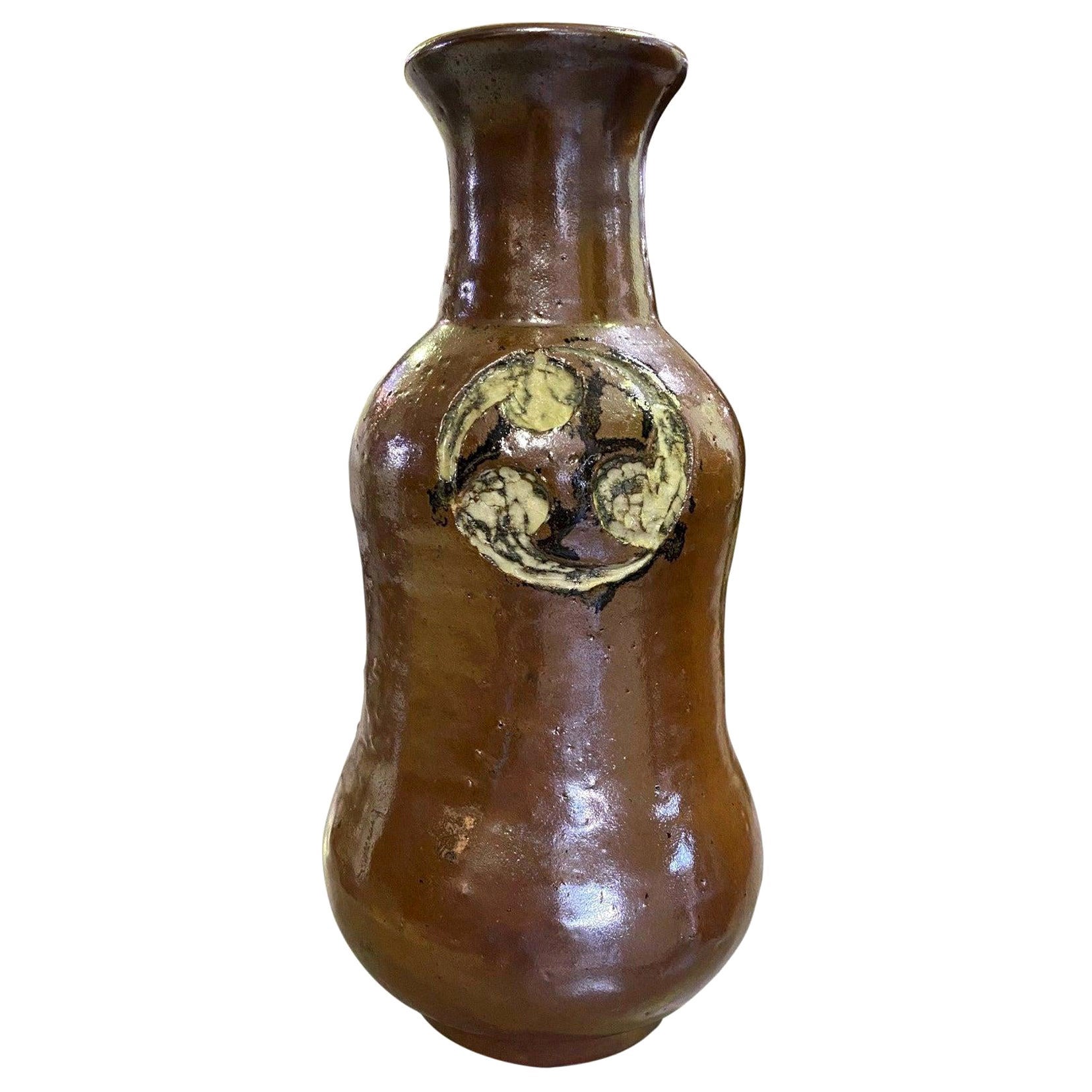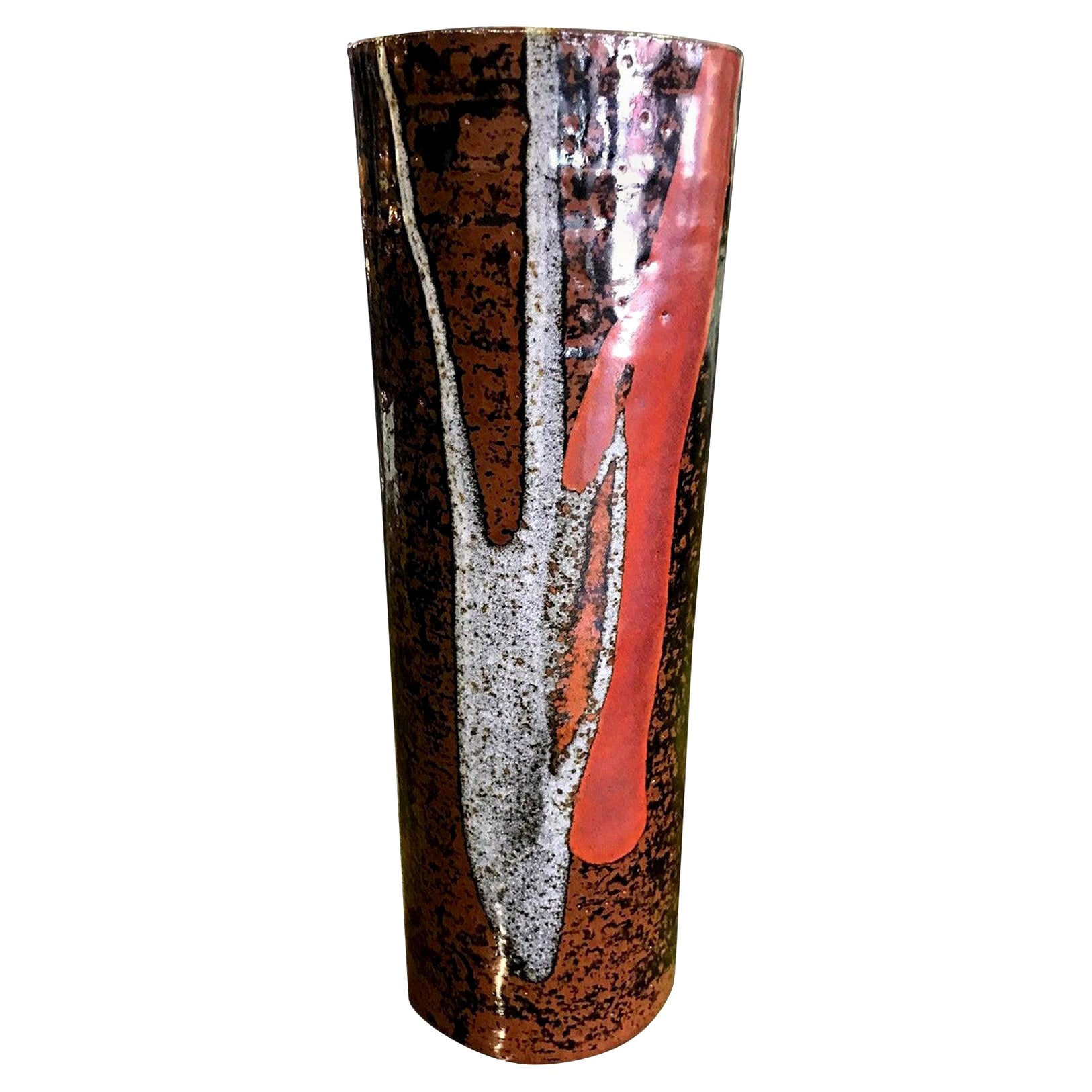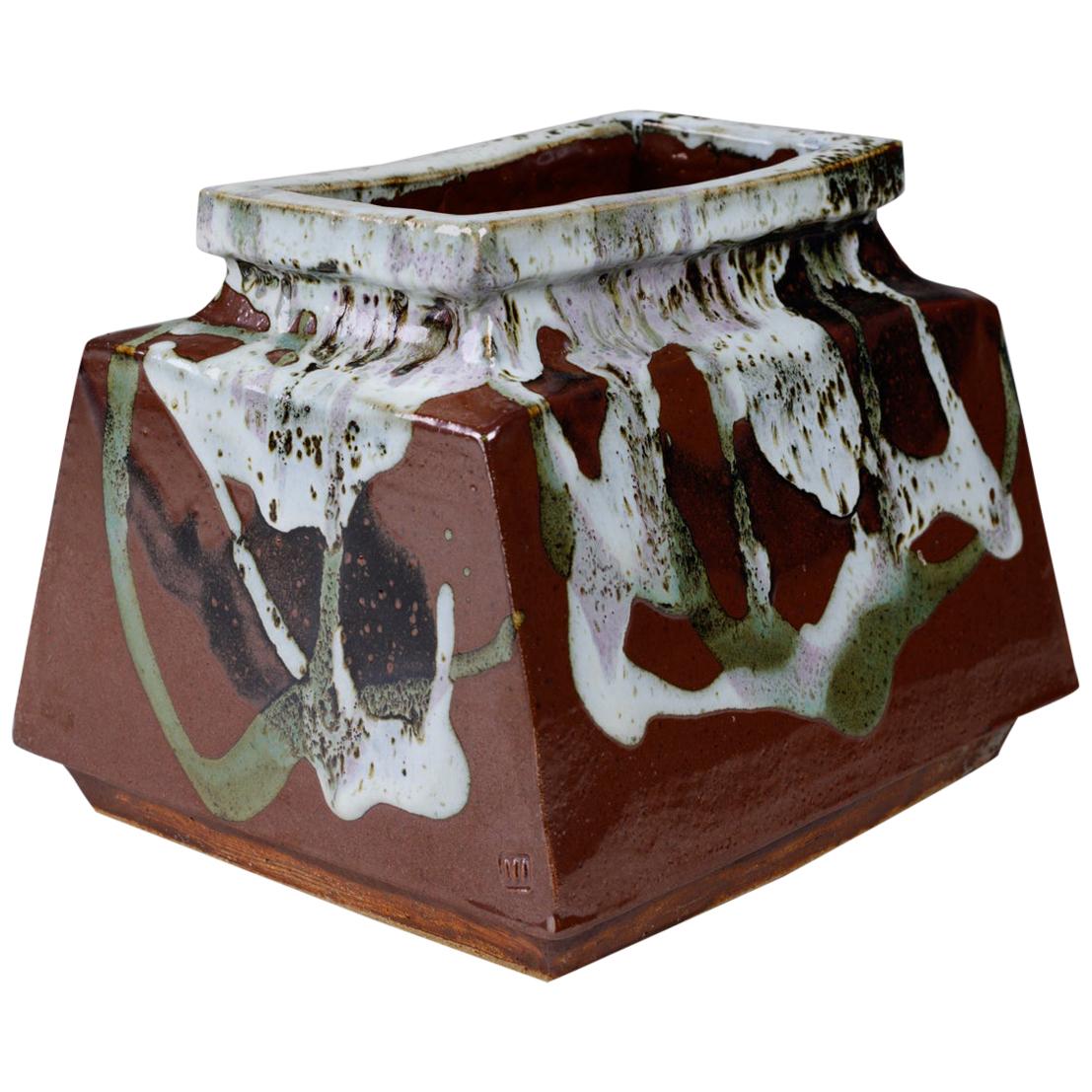Items Similar to Japanese Ceramic Vase Mingei Style Hamada Shoji
Want more images or videos?
Request additional images or videos from the seller
1 of 10
Japanese Ceramic Vase Mingei Style Hamada Shoji
About the Item
A heavily potted stoneware vase in cylindrical form, decorated with abstract strokes in iron rust glaze (known as Persimmon Glaze in Japanese) on a black glazed background. The pattern suggests autumn grasses, and it was applied with free hands. The vase is attributed to Japanese potter Hamada Shoji (1894-1978), who was a leading figure of the mingei Folk Art movement. He established his studio and practice in the Japanese town Mashiko to reinvent and spearhead the style that is both rustic and refined. From the renowned pottery center, he connected with international art communities by introducing the traditional Japanese pottery art to a wider world. In 1955 he was designated a "Living National Treasure", for the first time for someone from the field of crafts.
The vase is not signed, but it came with an old storage box with the hand-written label as shown.
- Attributed to:Hamada Shoji (Artist)
- Dimensions:Height: 8.2 in (20.83 cm)Diameter: 3.5 in (8.89 cm)
- Style:Arts and Crafts (Of the Period)
- Materials and Techniques:
- Place of Origin:
- Period:
- Date of Manufacture:1960s-1970s
- Condition:Wear consistent with age and use. Fine condition with minimal wear. With a storage box as shown.
- Seller Location:Atlanta, GA
- Reference Number:1stDibs: LU945020171052
About the Seller
5.0
Platinum Seller
These expertly vetted sellers are 1stDibs' most experienced sellers and are rated highest by our customers.
Established in 2006
1stDibs seller since 2010
479 sales on 1stDibs
Typical response time: <1 hour
- ShippingRetrieving quote...Ships From: Atlanta, GA
- Return PolicyA return for this item may be initiated within 2 days of delivery.
More From This SellerView All
- Japanese Mingei Glazed Tea Pot with Kintsugi by Shoji HamadaBy Shoji HamadaLocated in Atlanta, GAA Japanese stoneware tea pot by Hamada Shoji (Japanese 1894-1978) circa 1960-80s. The teapot is of the classic form and of a strong style of Mingei (folk ...Category
20th Century Japanese Modern Ceramics
MaterialsCeramic
- Large Japanese Satsuma Ceramic Vase KinkozanBy KinkozanLocated in Atlanta, GAA large Japanese ceramic vase from the end of Meiji period circa 1890-1910s by Kinkozan (1645-1927). One of the largest studio manufacturers of the export ceramics at the time based in Kyoto. In the typical style of satsuma made at the turn of 20th century, the vase is elaborately decorated with a rather unusual kinran-de (gold paint) and green enamel highlight on a mottled brown background. The painterly decoration depicts a large seasonal floral arrangement in a circular fashion. Besides the obviously superb craftsmanship, what sets this particular vase apart from many lower quality and mass-produced pieces is its tone-on-tone color pallet that is visually somber and the small and sensitive details that heralds the change of the seasons. When the viewer goes beyond the first casual glimpse of the blossom and foliage, one would notice that on the edges of certain leaves as well as along the stalks, there accumulates a very thin layer of the white dust that represents the frost. The flower in bloom are chrysanthemums. Despite of being splendid, they are the messengers of the autumn. The large lotus leaf was subtly rendered in a bended and slightly withered manner, just past its prime. Although the lotus is still in bloom, the prominent seed pod indicates it may be the last for the season. The sentimental capture of the change of the seasons is not unusual in Japanese art. This vase poetically represents such a subtle transition from summer to fall, perhaps depicting the very first frost. The neck of the vase is also slightly unusual with two rolled rings...Category
Early 20th Century Japanese Meiji Ceramics
MaterialsCeramic
- Japanese Mishima Ceramic Vase Meiji PeriodLocated in Atlanta, GAA Japanese long neck slender ceramic vase in the style of Mishima, circa 19th century, Meiji period. Mishima pottery was originally imported from three islands in Taiwan and then fro...Category
Antique 19th Century Japanese Japonisme Ceramics
MaterialsCeramic
- Fine Japanese Ceramic Satsuma Vase by KinkozanBy KinkozanLocated in Atlanta, GAA miniature Japanese ceramic vase from the end of Meiji period circa 1880s- 1910s by Kinkozan (1645-1927). One of the largest studio manufacturers of the export ceramics at the time ...Category
Early 20th Century Japanese Meiji Ceramics
MaterialsCeramic
- Japanese Ceramic Ikebana Vase Bizen Ware Nanba KoyoLocated in Atlanta, GAA tall vintage ceramic vase with handle from Japan (20th century) by Nanba Koyo. Made in the tradition of Bizen ware, the vase has a modern aesthetic with a...Category
20th Century Japanese Japonisme Ceramics
MaterialsCeramic
- Fine Japanese Ceramic Vase Makuzu Kozan Meiji PeriodBy Makuzu KozanLocated in Atlanta, GAA Japanese long neck porcelain vase circa 1900-1910s by the studio of Miyagawa Kozan (1842–1916), one of the most established and collected Japanese ceramist from the end of Meiji Period. Commonly known as Makuzu Kozan, which also appears as the signature on his work, his originally birth name was Miyagawa Toranosuke. He was the appointed artist to the Japanese Imperial household and his work was exhibited in many international fairs that the Meiji government participated at the turn of the century. This vase features an elegant Classic form with a slender neck and slightly flared mouth above a baluster body. It was finely painted with two swimming carps in a copper red underglaze among green ribbons like waves. The background display a brilliant verdant green overall, Around the fish a poetic hazy effect was emphasized for a visual complexity by Fuki-e (the blow painting), an invention in Kozan's studio. The new technical development of chemical colors from the west was embraced circa 1900s in Kozan studio. This empowered the more creative experiments with not only colors, but also concept of dimension, which led Makuzu Kozan's work to become a bridge between East and West aesthetics. This is particularly evident in this vase with the Masterly details of the brush strokes, the expertly employment of gradient of color, and a very realistic and detailed rendering of the fish and their vivid motions. For two similar examples of Kozan's work with similar carps decoration, see Page 148-149 of the book: Sekai ni Aisa Reta ya Kimono Miyagawa Kozan Makuzu...Category
Early 20th Century Japanese Meiji Ceramics
MaterialsCeramic
You May Also Like
- Shoji Hamada Mingei Kakiyu Kaki Glaze Vase with Original Signed and Sealed BoxBy Shoji HamadaLocated in Studio City, CAAn exquisite, beautifully crafted, and designed gourd vase by master Japanese potter Shoji Hamada, which features a fine example of his famed rich Kaki or persimmon glaze. The original Hamada stamped/sealed and signed box is included. Rare to find such a beautiful piece in such impeccable condition with its original signed box. Hamada named this vase Kaki-Yu-Kabin (flower vase with Kakiyu glaze). A very rare form. One Japanese ceramic dealer whom we know said he had only seen one or two other examples like this by Hamada before. This work is sure to shine in any Japanese pottery/art collection or setting. Shoji Hamada was designated a Living National Treasure in Japan in 1955. In 1968 he received Japan's highest artistic award the Order of Culture. His work can be found in collections and museums worldwide including Tokyo’s Japan Folk Art Museum and The Tate Museum...Category
Mid-20th Century Japanese Showa Ceramics
MaterialsStoneware
- Japanese Midcentury Large Glazed Pottery Vase in the Manner of Shoji HamadaLocated in Studio City, CAA really large and wonderful piece. Clearly, the maker was a fan of Shoji Hamada's work. Signed on the base along with a sticker on the inside that seems to read 2 - 66, perhaps F...Category
Vintage 1960s Japanese Showa Ceramics
MaterialsEarthenware
- Shoji Hamada Japanese Earth-Toned Glazed Vase with Original Signed Sealed BoxBy Shoji HamadaLocated in Studio City, CAAn exquisite, beautiful flower vase by master Japanese potter Shoji Hamada featuring an example of his popular two-color, sumptuous earth-toned ...Category
Early 20th Century Japanese Showa Ceramics
MaterialsStoneware
- Shoji Hamada Tenmoku Glaze and Kaki Trailing Vase and Original Signed Sealed BoxBy Shoji HamadaLocated in Studio City, CAAn exquisite, beautifully crafted Japanese pottery vase by master potter Shoji Hamada featuring Hamada's famous signature tenmoku glaze with kaki trailing. The original Hamada signed and sealed wood storage box is included as well as the written appraised signature of his son Shinsaku Hamada. The vase also comes with a printed artist profile/sales brochure of Hamada (featuring some of his other presumably available work). It appears this piece was offered at the Keio Department store in Shinjuku, Tokyo. At first glance, this may seem odd but in fact, this is quite an honor in Japan. This store is known for selling and exhibiting such high-profile artists and potters as Bernard Leach, Lucie Rie, Gyokudo Kawai, Shiko Munakata, Kawai Kanjiro, and Rosanjin Kitaoji. A major goal of many ceramic artists in Japan is to have a one-man exhibition in a department store. For many Westerners, this is a strange concept. Some of the larger department stores have up to three or four dedicated galleries showing concurrent art exhibitions. A well-known artist's exhibition can bring in hundreds, often thousands, of customers to a store and increase revenue for other sales in the millions-of-yen range. These exhibits are usually longer running and highlight a potter's career, like a Living National...Category
Mid-20th Century Japanese Showa Ceramics
MaterialsStoneware
- Japanese Ceramic VaseLocated in Palm Desert, CAVery unique Japanese vase with abstract pattern in a variety of brown tones. The deepest brown glaze is raised, giving the vase a wonderful tactile texture.Category
Late 20th Century Japanese Organic Modern Vases
MaterialsCeramic
- Modern Japanese Ceramic VaseLocated in Hudson, NYModern Japanese ceramic vase, the title of this piece is "Kaki yu" or "Persimmon glaze". Rectangular vase, with abstract design and heavy glazin...Category
Vintage 1970s Japanese Showa Ceramics
MaterialsCeramic
Recently Viewed
View AllMore Ways To Browse
Living National
Japanese Style Furniture
Japanese Vintage Style
Ceramic Japan
Ceramics From Japan
Japan Pottery
Japanese Style Traditional
Arts Crafts Japanese
Iron Rust
Japanese Glazed Ceramic
Vintage Japanese Patterns
Vintage Japanese Pattern
Treasure Craft
Japanese Ceramic Vases
1970s Ceramic Art
Traditional Vintage Japanese Art
Ceramic Arts Studio
Japanese Arts And Crafts





